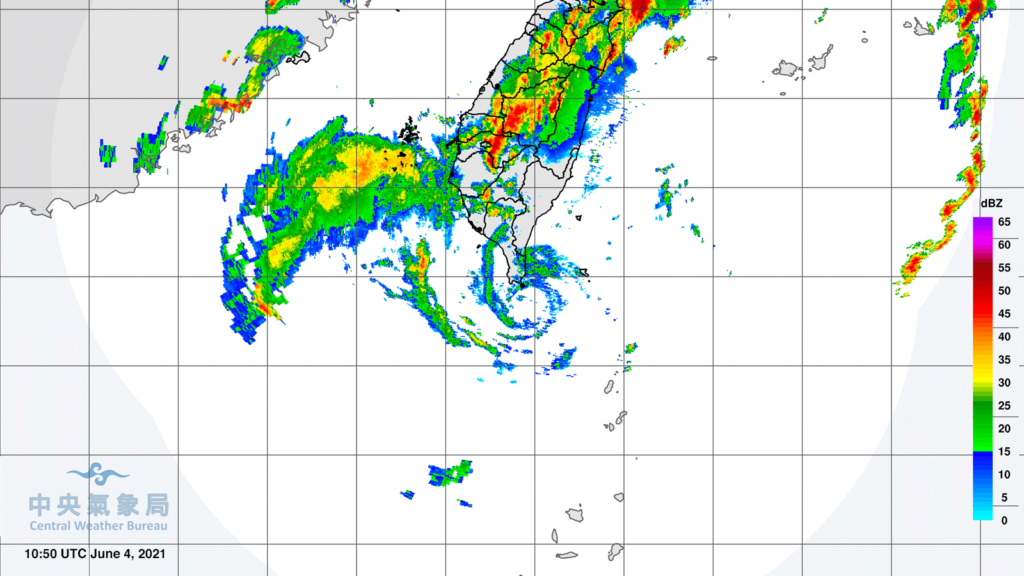Tropical Depression Choi-wan skirted the eastern side of Taiwan on Friday, bringing heavy rains to a nation desperate for water in light of its worst drought in over 50 years. In the 24 hours ending at 16 UTC June 4, rains in excess of 200 mm (about 8 inches) had fallen in northern and central portions of Taiwan. The heavy rains will help ease fears of drought-related production problems for the island’s critical semiconductor industry, at a time when a global computer chip shortage is playing havoc with businesses worldwide.
Choi-wan, 2021’s fourth Northwest Pacific named storm (as tracked by the Joint Typhoon Warning Center), formed on May 30 in the waters east of the Philippines. After reaching a peak intensity of 50 mph, Choi-wan moved through the Philippines, with heavy rains causing flooding and landslides blamed for the deaths of eight people; 15 others are missing. High wind shear prevented Choi-wan from intensifying as it approached Taiwan, giving just what the island needed: a weak tropical depression with plenty of rain, but no damaging winds or storm surge.
World’s economy depends on adequate rains in Taiwan
Taiwan is home to the world’s largest semiconductor chip manufacturer, Taiwan Semiconductor Manufacturing Company (TSMC). According to the New York Times, more than 90 percent of the world’s manufacturing capacity for the most advanced computer chips is in Taiwan and run by TSMC, which makes chips for Apple, Intel, and other major companies. TSMC says the drought has not decreased its production so far, but its operations certainly have been affected: The company has been forced to use water tankers to supply water to its thirsty chip plants, accounting for about 2% of its quarterly operational costs, according to the Taiwan News. The drought has also helped trigger multiple blackouts in May that affected millions of people in Taiwan, though the critical semiconductor factories were not directly affected.
Taiwan’s drought exacerbated by lack of tropical cyclones
Tropical cyclones (the catch-all term for all tropical depressions, tropical storms, and hurricane-strength typhoons) are crucial to Taiwan’s water supply. According to a 2017 article by Alice Liang and colleagues, “Long-term trends of typhoon-induced rainfall over Taiwan: In situ evidence of poleward shift of typhoons in western North Pacific in recent decades,” tropical cyclones account for nearly 50% of the total annual rainfall in Taiwan. Thus, when no tropical cyclones hit Taiwan’s main island during 2020, the island’s drought entered record-breaking territory. Drought conditions had already been a problem in 2020 given the late arrival and meager offerings of the seasonal May/June Meiyu rains (also called the “plum” rains).
Climate change linked to fewer typhoons affecting Taiwan
Over the past 40 years, a significant decrease in the number of tropical cyclones affecting the waters near and to the southeast of Taiwan has been observed (Figure 4). According to NOAA’s historical typhoon track database, Taiwan averaged approximately two tropical cyclone landfalls per year from 1981-2020; during the most recent 10-year period (2011-2020), an average of only 1.5 landfalls per year occurred. This is nearly a factor of two below the 2.8 landfalls per year observed during the previous 10-year period. The relative lack of typhoon landfalls has been caused by a weakening of the western North Pacific subtropical high, which has in turn led to weakened typhoon steering currents and a more northerly track for the storms. The authors of “Long-term trends of typhoon-induced rainfall over Taiwan: In situ evidence of poleward shift of typhoons in western North Pacific in recent decades” wrote that this shift is “consistent with the expansion of the tropics due to climate change”.
In a 2019 review paper by 11 hurricane scientists, “Tropical Cyclones and Climate Change Assessment: Part I. Detection and Attribution,” all 11 authors concluded that a poleward migration of where typhoons attain their maximum intensity in the western North Pacific basin had occurred; nine of 11 authors concluded that human-caused climate change had contributed to the observed migration.
Climate change linked to a delayed rainy season
Much of the shortfall in the 2020-2021 rains over Taiwan resulted from the late arrival of the seasonal Meiyu rains. A 2016 paper by Wang and colleagues, “Interdecadal change of the active-phase summer monsoon in East Asia (Meiyu) since 1979,” found that these rains have intensified since 1990, but have shifted later (from late May to early June). The authors suggested that human-caused climate change might play a role in this shift.
When rainfall does occur in Taiwan, it is occurring in heavier rainfall events, of the type likely to cause flooding; a 2021 paper by Henny and colleagues, “Extreme Rainfall in Taiwan: Seasonal Statistics and Trends,” found that in many areas, extreme rainfall events in Taiwan had increased by more than 1% per year over the past 56 years as a result of both typhoons and the seasonal Meiyu rains.
In summary, climate change has likely increased the odds of the frequency and severity of droughts like the 2020-2021 one in Taiwan, due to fewer tropical cyclones and later-arriving seasonal rains. With hotter global temperatures also making droughts more intense, the future drought situation in Taiwan could well cause significant disruptions to the critical semiconductor industry, which has concentrated its operations on the island. Unfortunately, when the needed rains in Taiwan do come, they are more likely to be extreme.
Website visitors can comment on “Eye on the Storm” posts. Please read our Comments Policy prior to posting. Comments are generally open for 30 days from date posted. Twitter: @DrJeffMasters and @bhensonweather
